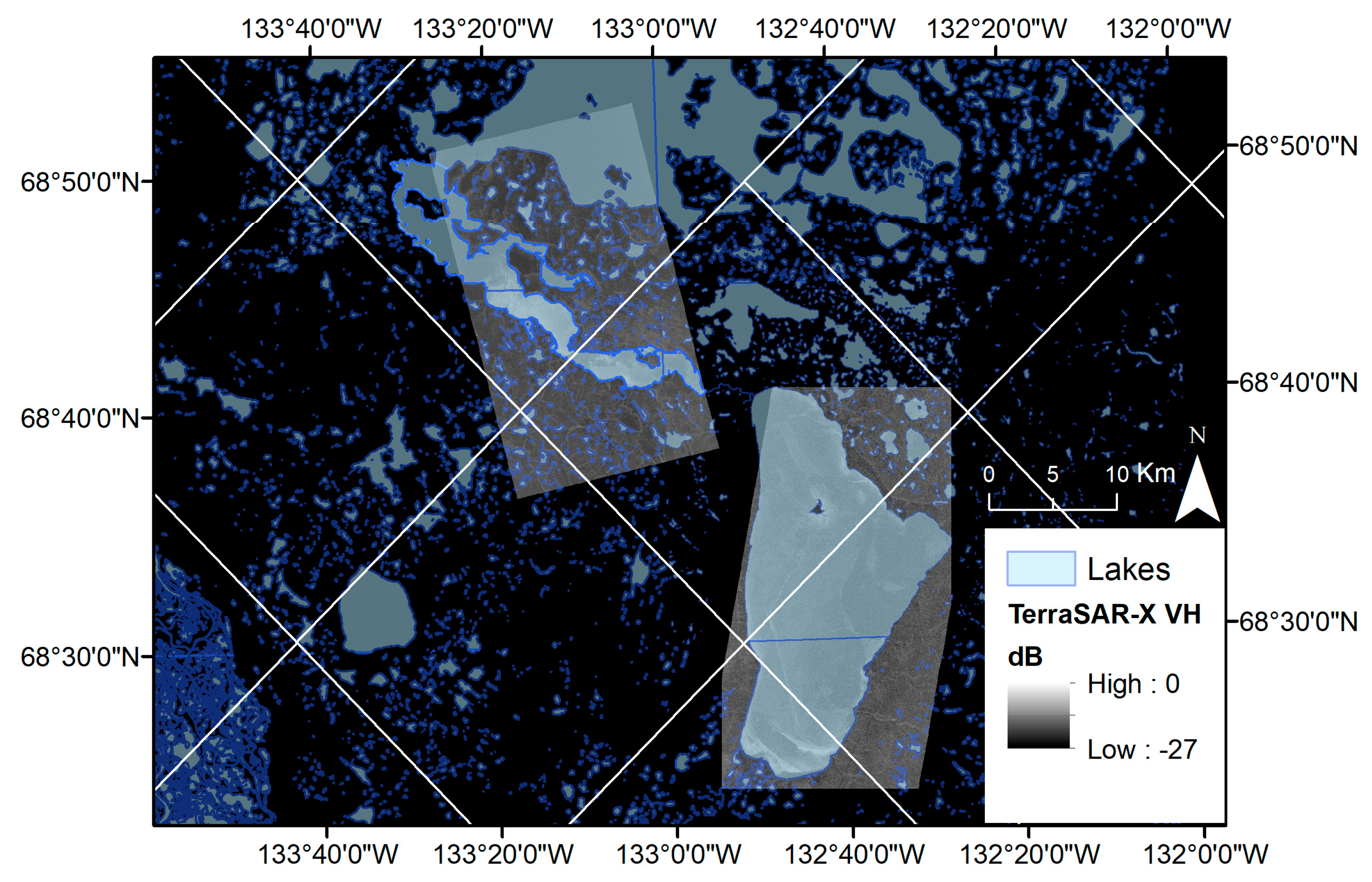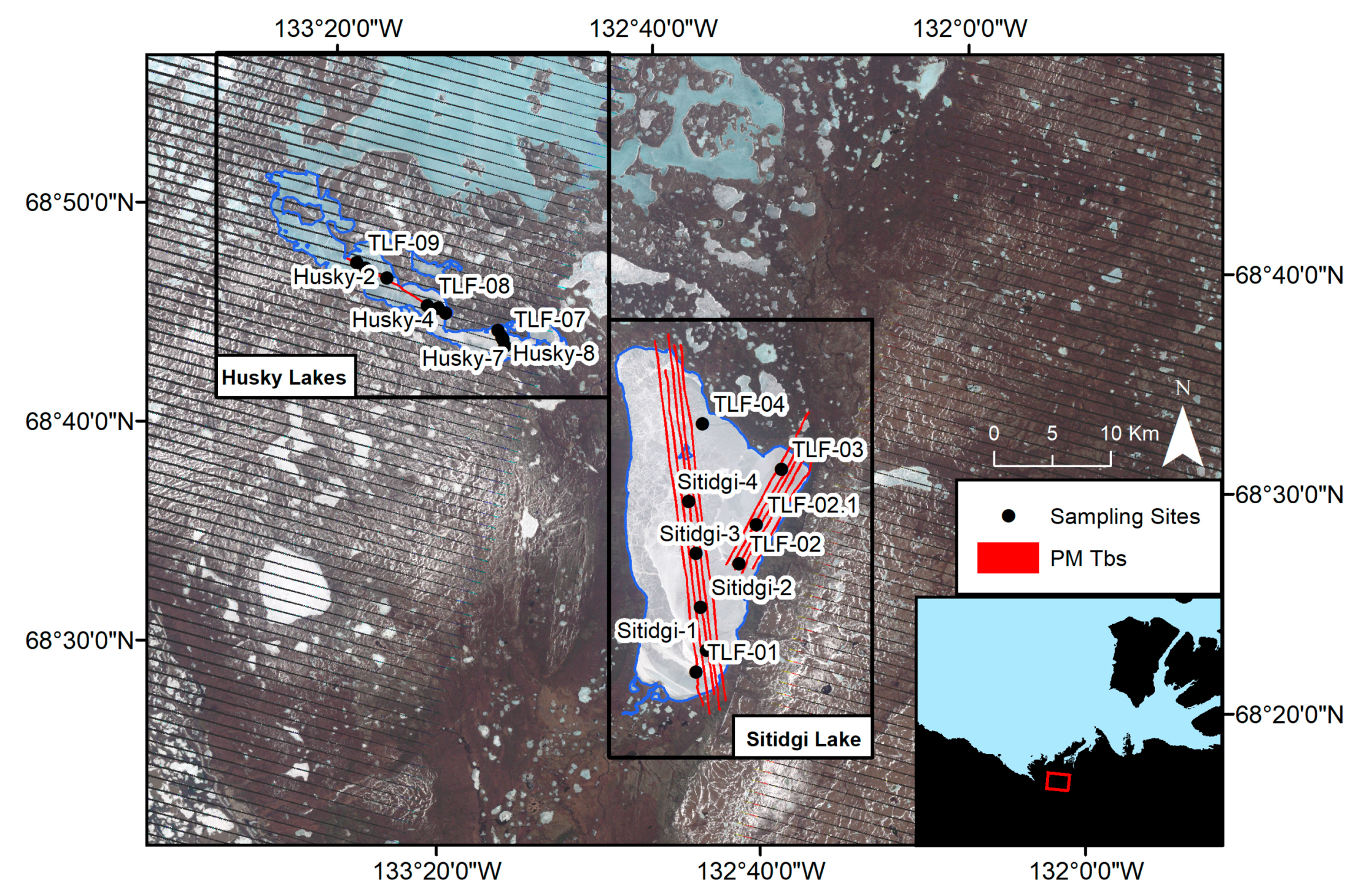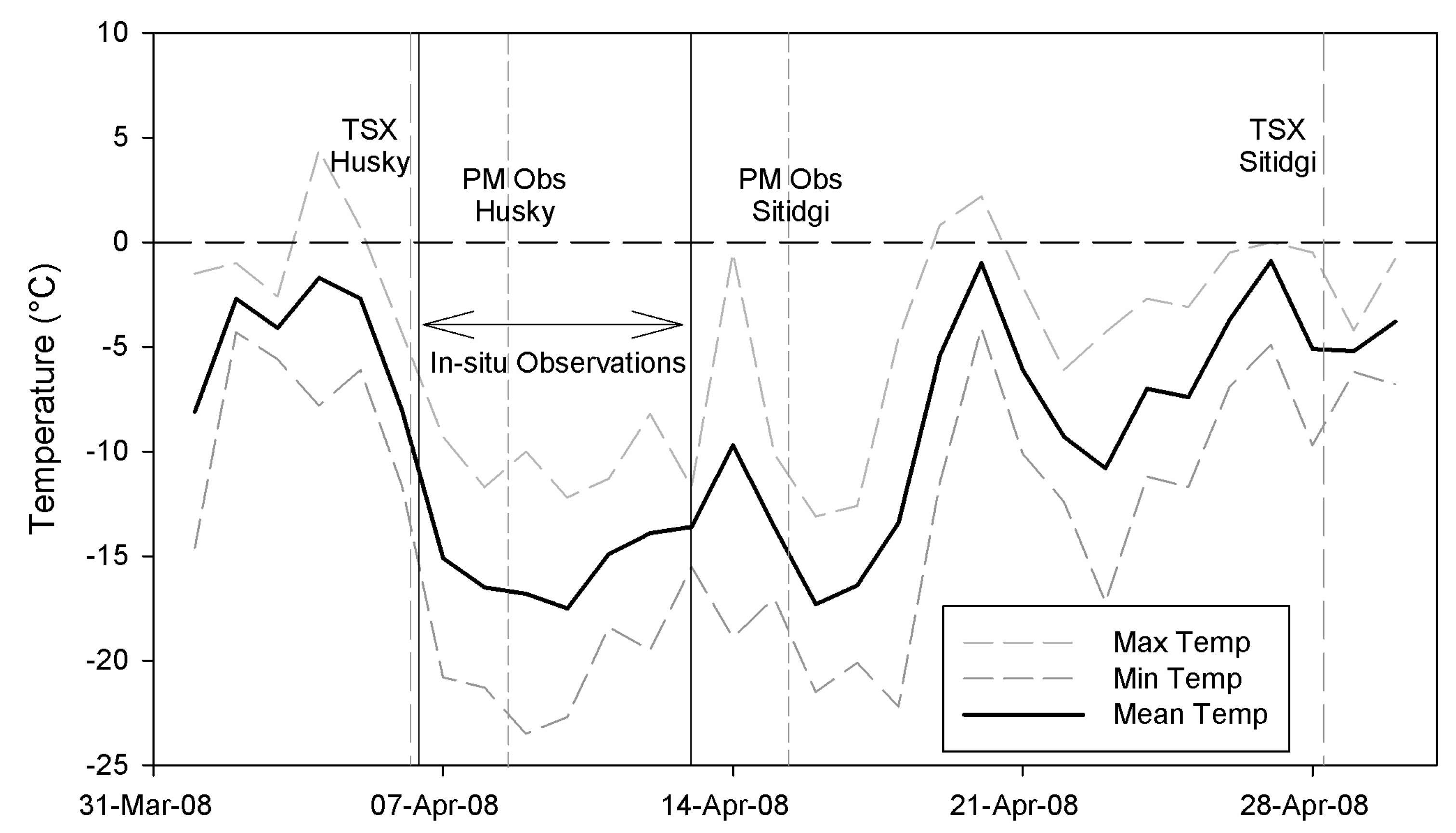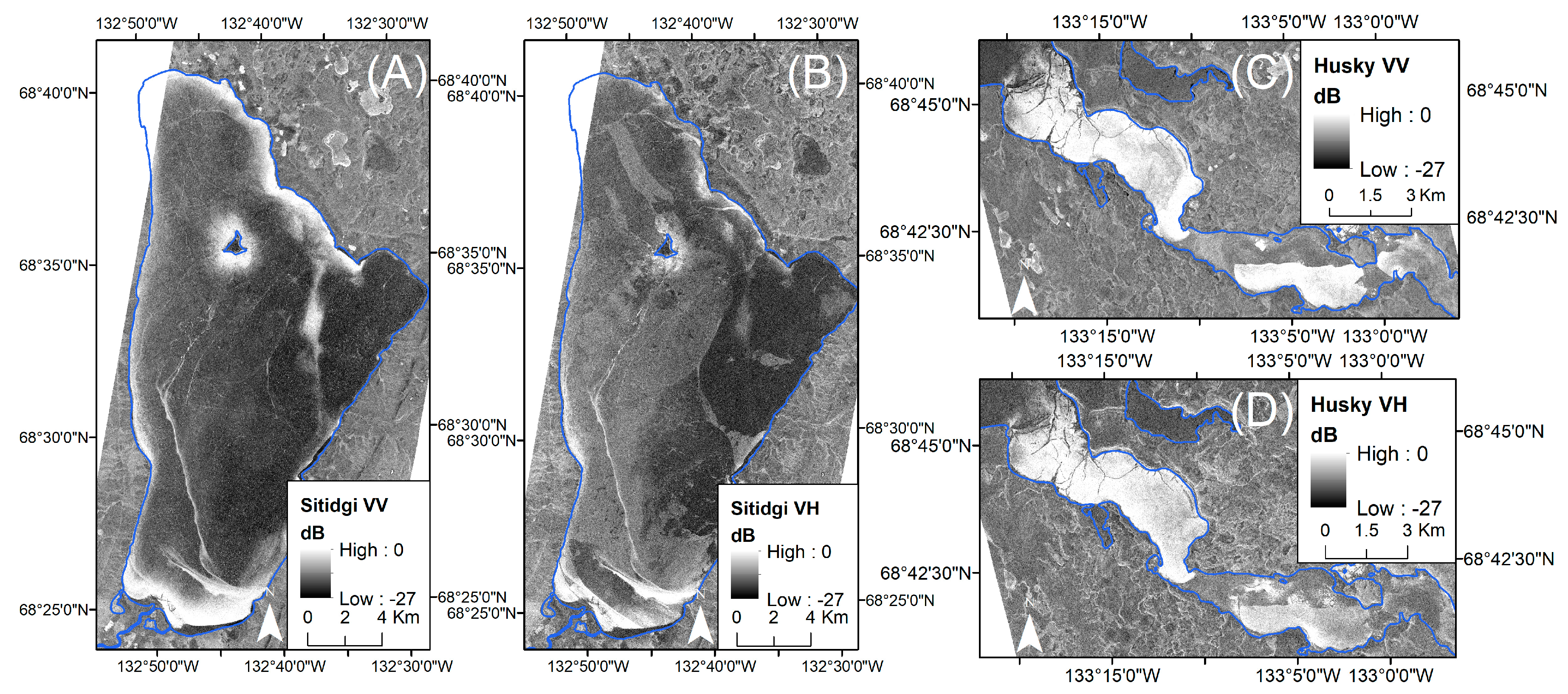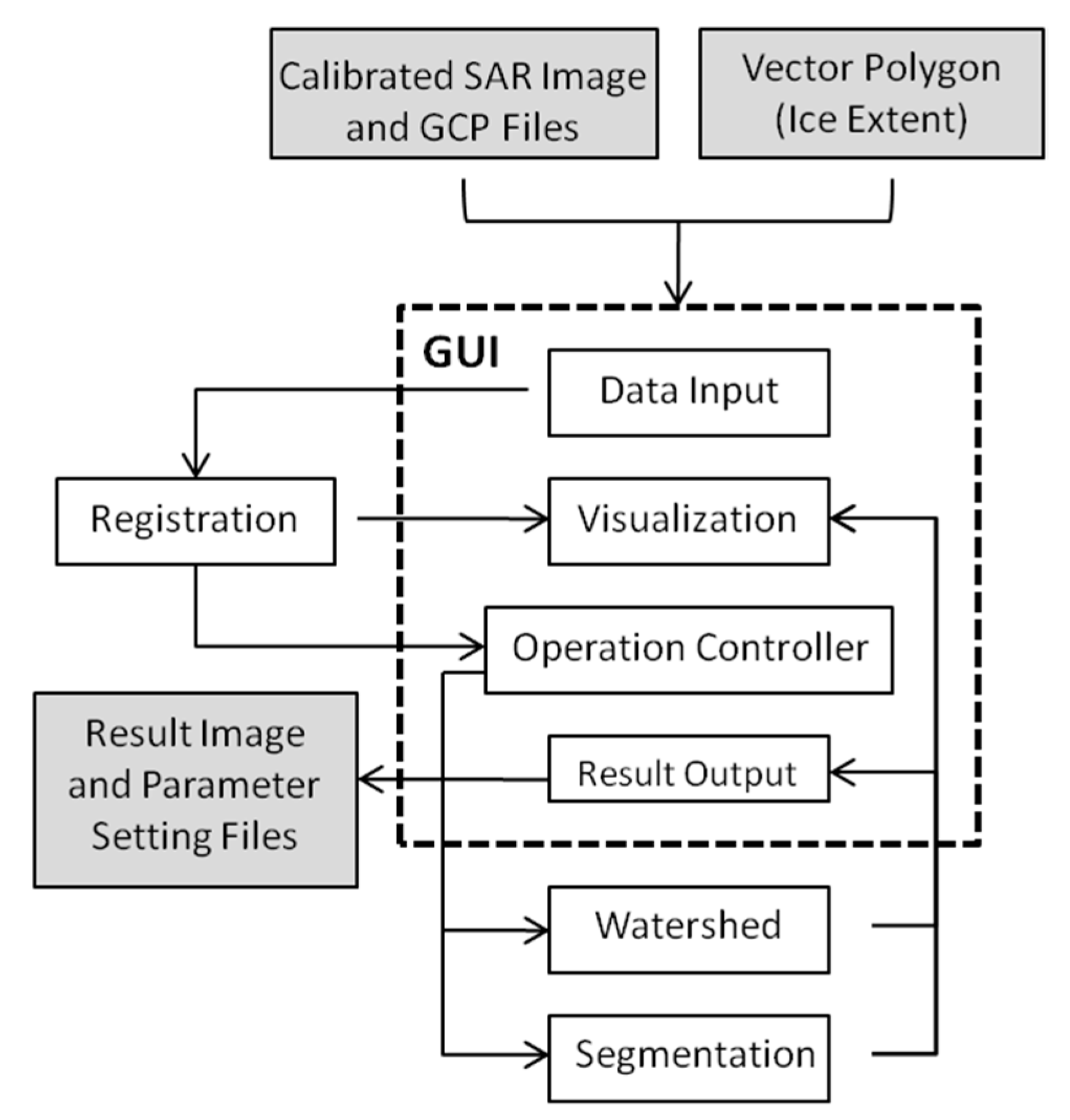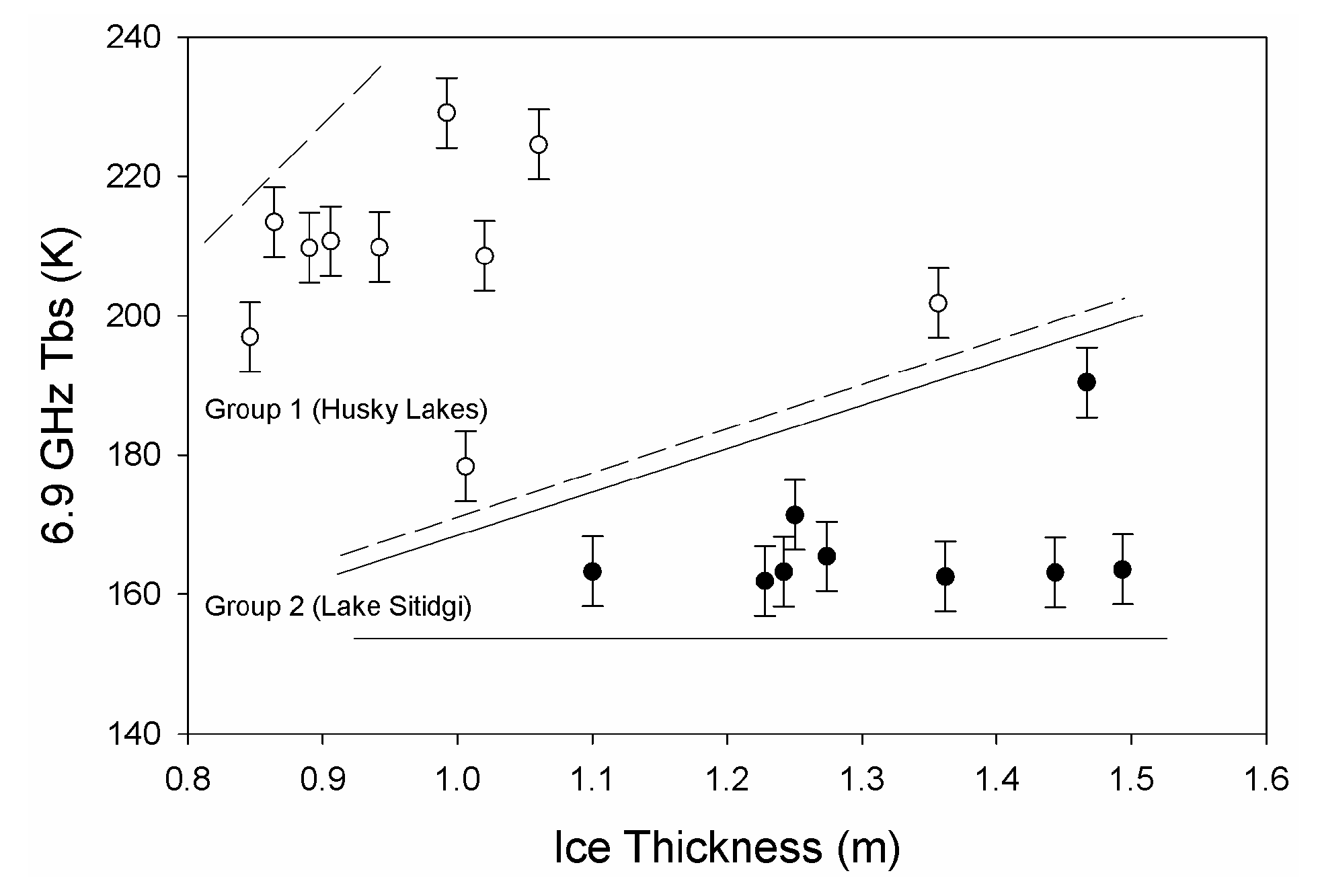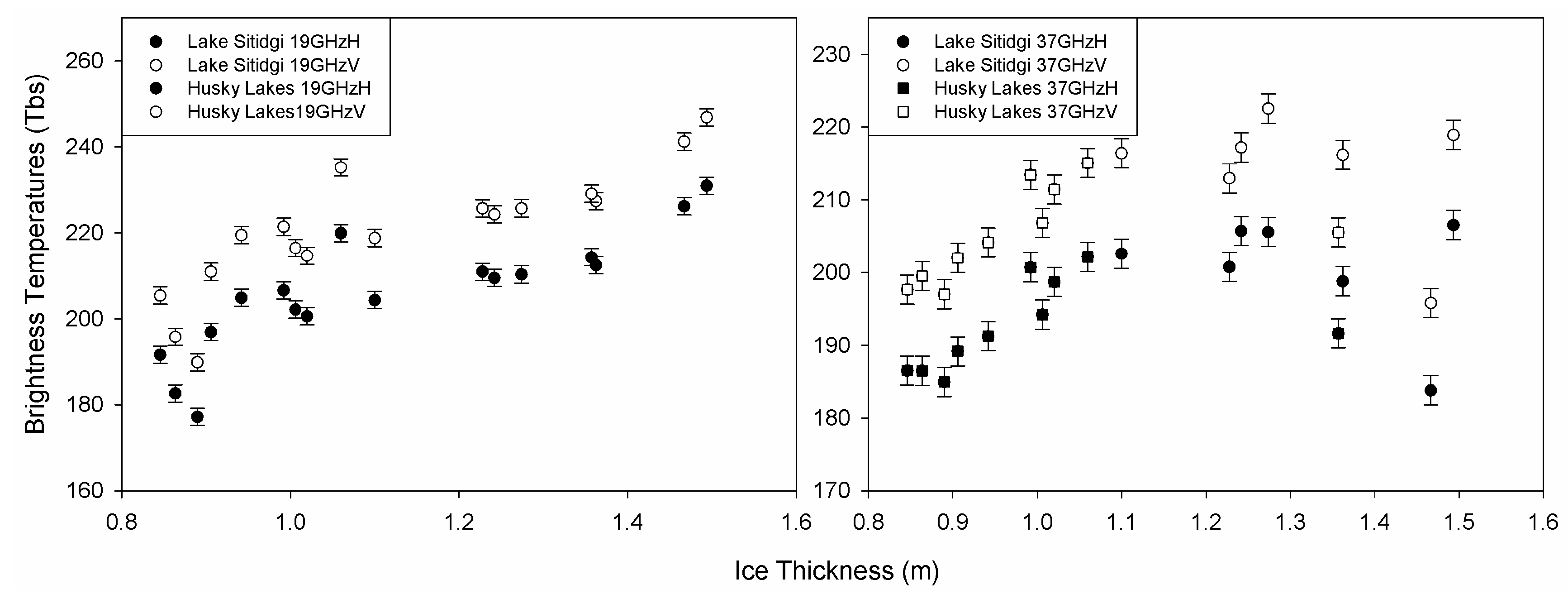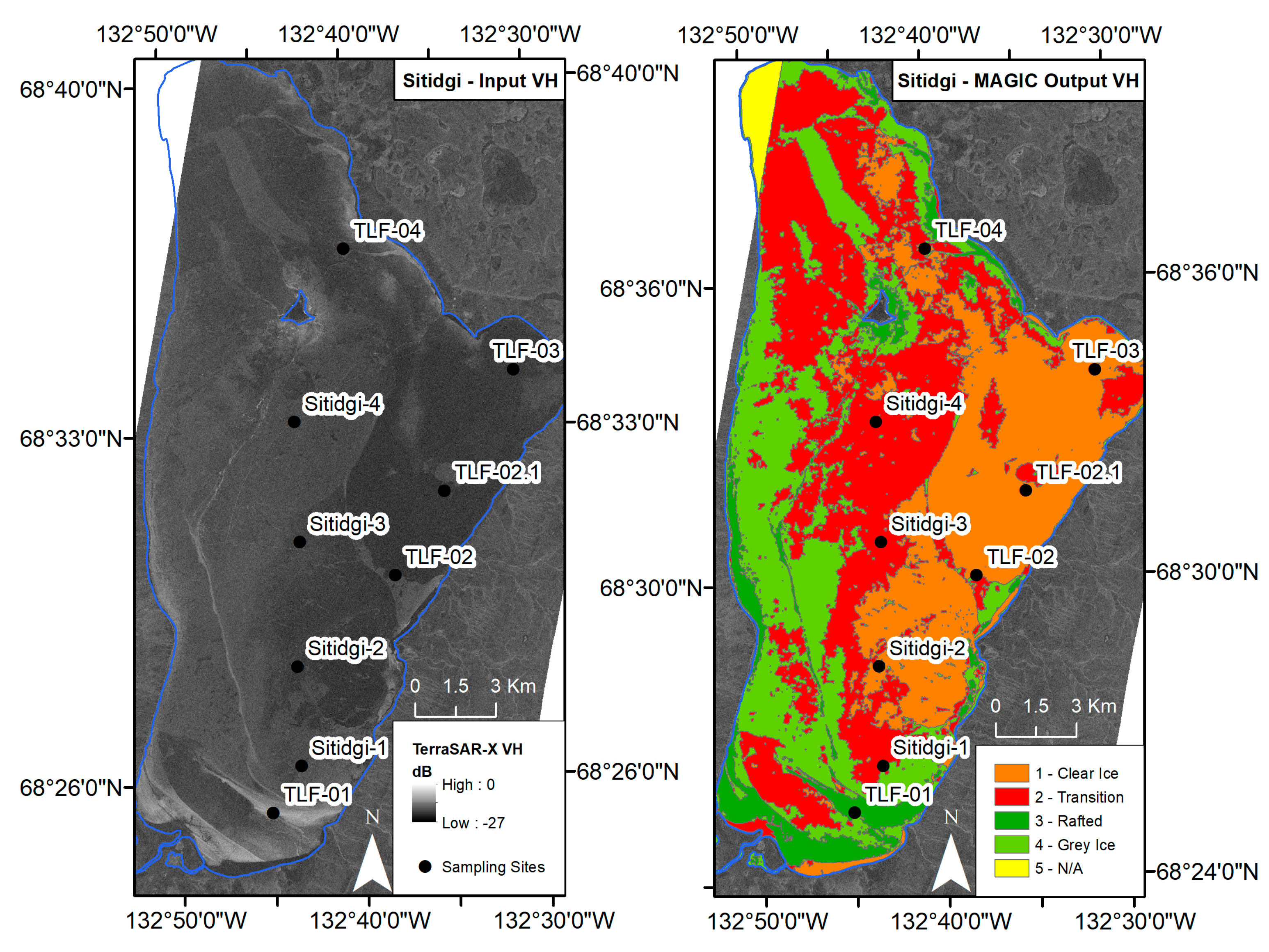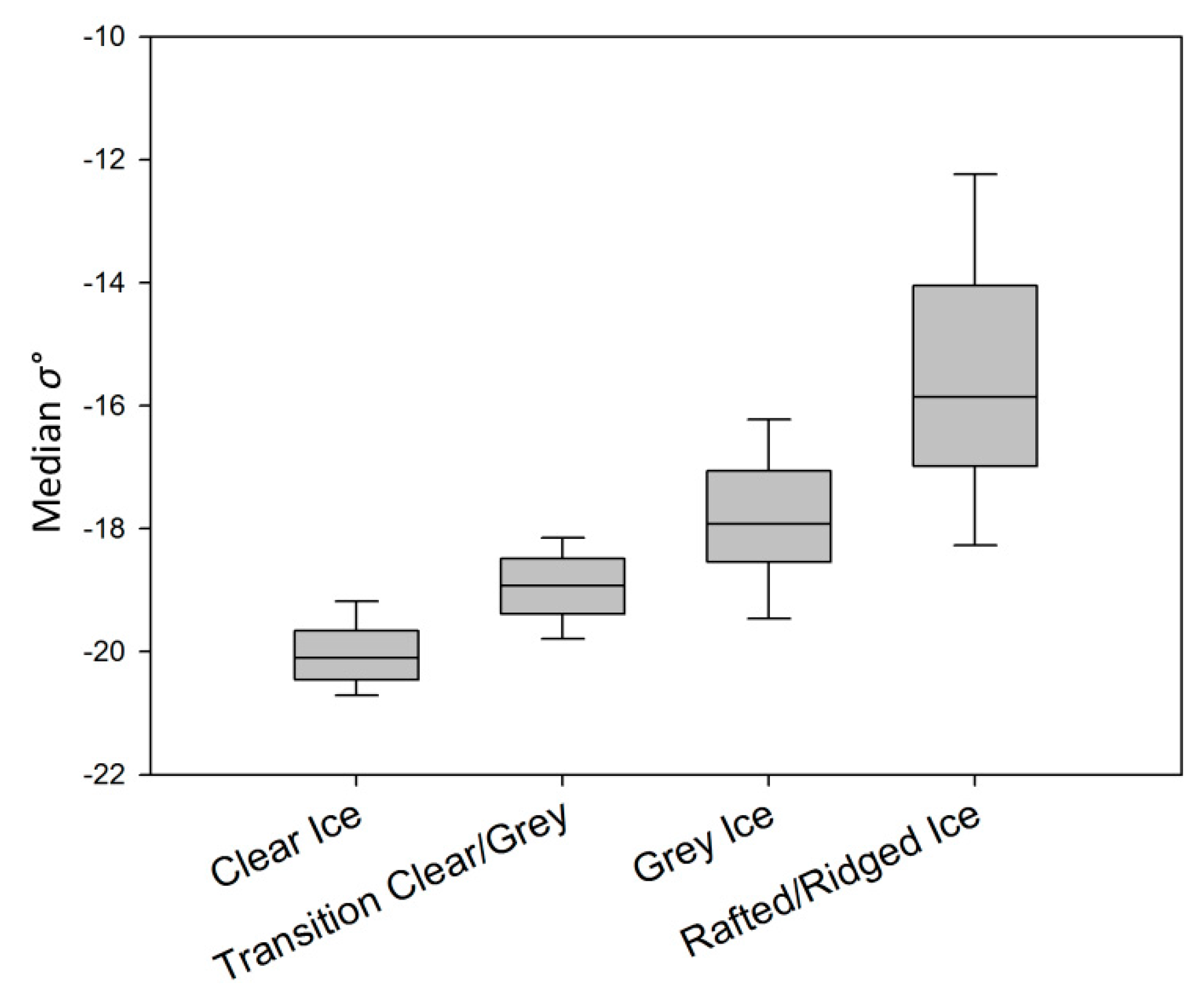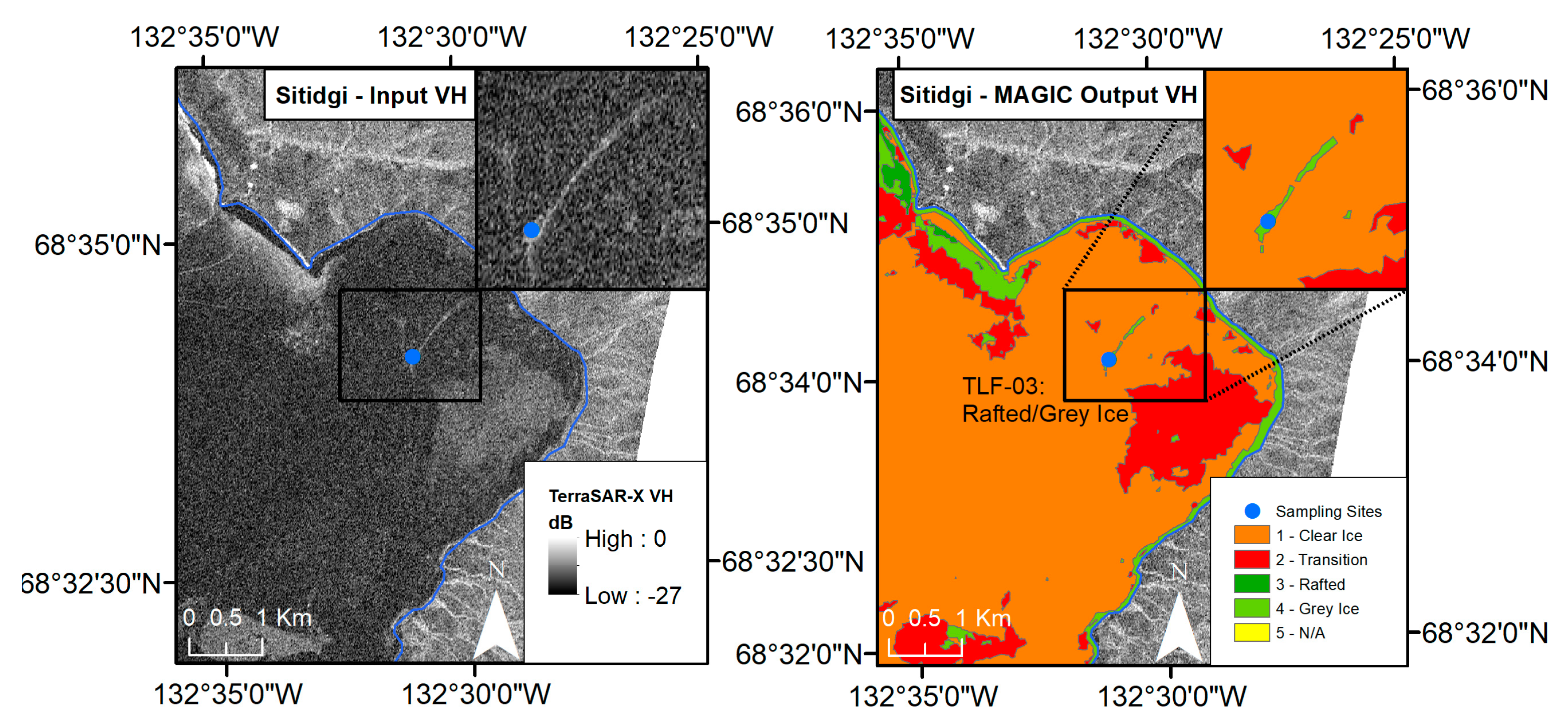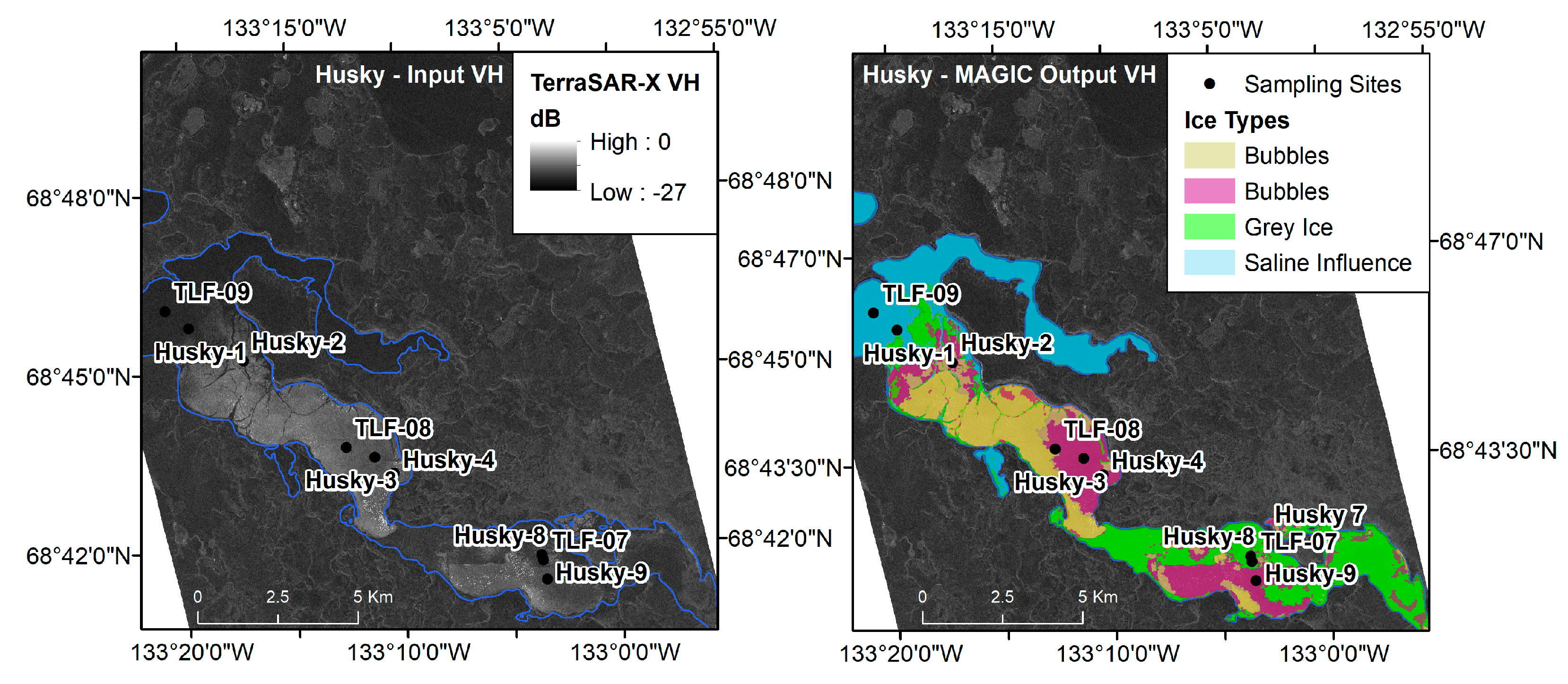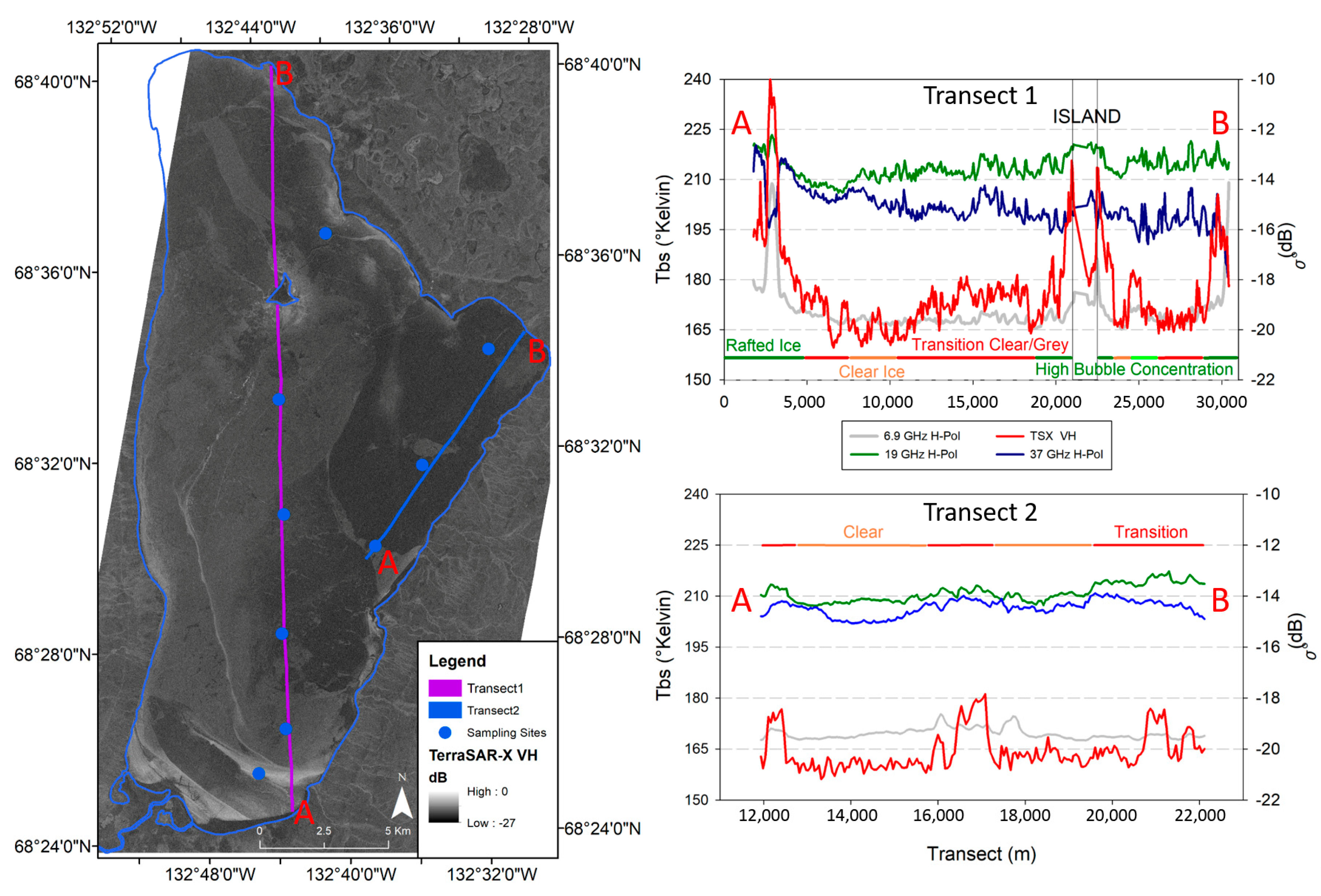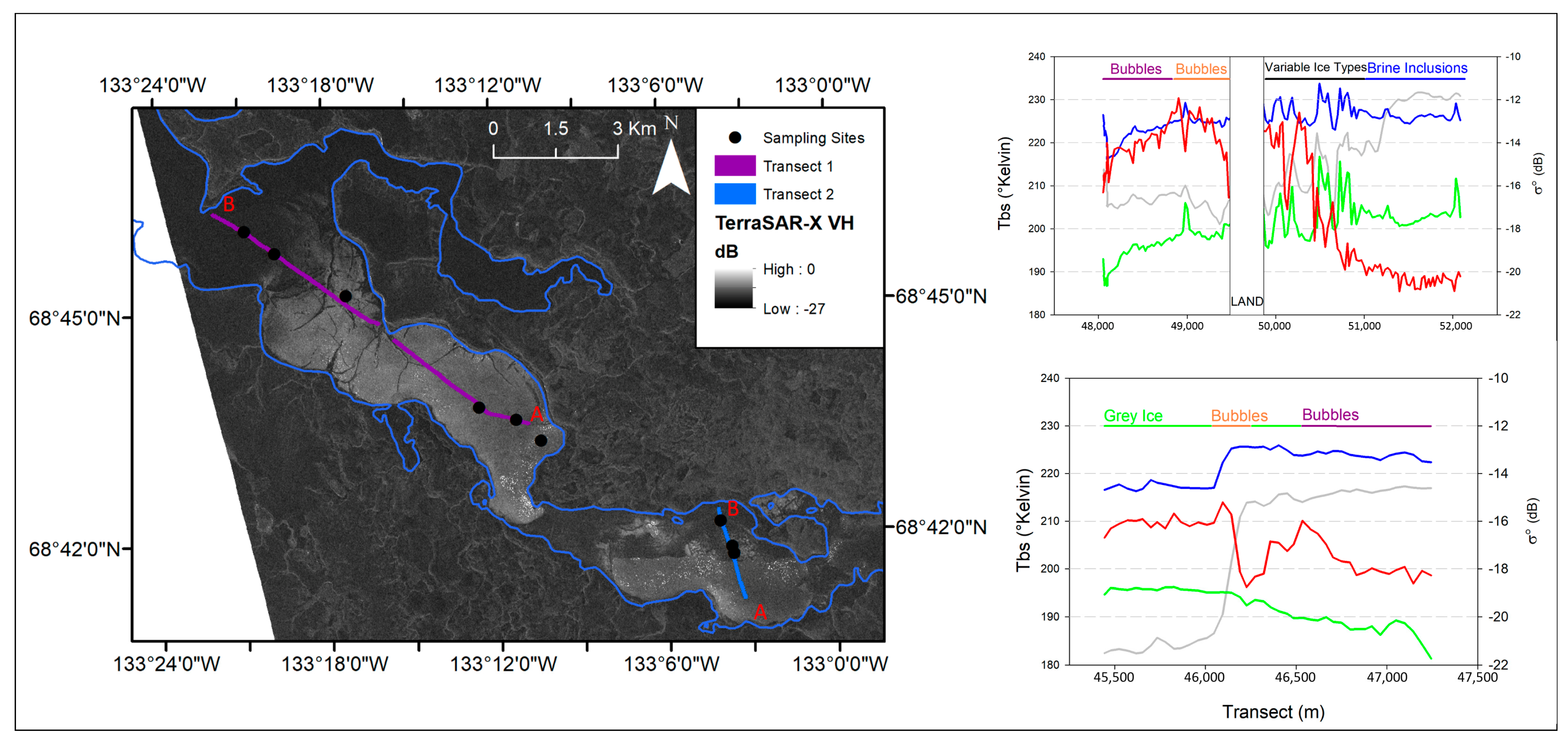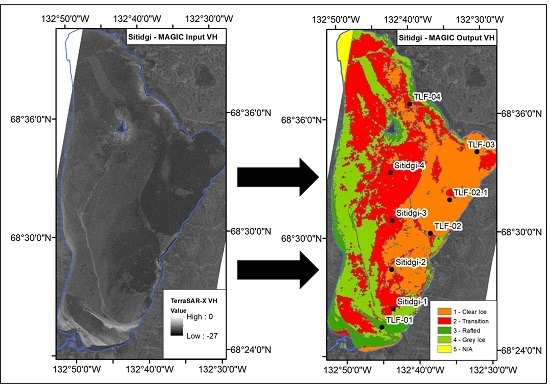1. Introduction
Seasonal snow and ice in Arctic and sub-Arctic environments represent a significant amount of annual water storage within the hydrological cycle. Monitoring of snow and ice properties is important for both economic and scientific considerations. Economically, snow is a source of sustenance and electricity, providing drinking water to northern communities and fueling hydroelectric dams, bringing a considerable economic benefit [
1,
2]. Concurrently, the presence (phenology) and knowledge of ice thickness allows for winter transport to remote locations that otherwise lack land-based access [
3]. Accurate snow and ice datasets including snow extent, snow water equivalent (SWE), and lake-ice phenology and thickness are important to assess output from regional climate models, and are also key indicators for global climate assessment research [
4,
5,
6,
7]. An accurate observational cryosphere monitoring network in high latitudes is of critical importance in time series examinations, as polar regions have been identified as increasingly sensitive to changes in surface air temperature [
8].
Conventional measurement of snow and ice variables in high latitude environments are obtained through in situ surveys. The surveys are adequate to derive snow and ice parameters locally at specific time instances, but up-scaling of observations to regional scales can be biased by extreme local-scale (order of hundreds of meters) variability of snow and ice (confounded by variable lake size, depth and inflow/outflow patterns). Surveys are also generally restricted to populated regions and are intermittent, as the collection of cryospheric variables is logistically cumbersome in remote regions [
9].
Passive microwave (PM) remote-sensing measurements from polar orbiting satellite sensors such as the Special Sensor Microwave Imager (SSM/I) and the Advanced Microwave Scanning Radiometer (AMSR-E and AMSR-2) allow for the regular observation of data at large scales in northern Canada where in situ data is difficult to collect, as they provide continuous daily measurements for large swaths and function independently from solar radiation. Traditionally, SWE retrieval algorithms have been derived by linearly relating in situ snow measurements to the differences between a frequency that is scattered by snow grains and a frequency that is largely transmitted through the snowpack (37 GHz and 19 GHz, respectively) like Chang’s (1) hemispheric algorithm, which uses an assumed snow density of 300 kg/m
3 [
10]. This approach is extended by empirical fits to be tailored to regional and landcover-specific environments such as the Meteorological Service of Canada’s (MSC) open environment (2) algorithm [
11,
12,
13], which similarly assumes emission at the lower-frequency channel remains relatively consistent. In Equations (1) and (2), T
bS are input as K.
In lake-rich environments, T
b-difference algorithms tend to underestimate SWE due to variable emission patterns caused by the influence of radiometrically cold water from beneath the ice–water interface [
13]. Emission variability is dependent on the penetration depth (
) at specific frequencies, influenced heavily by ice thickness. The penetration depths for 19 and 37 GHz calculated by [
14] and [
15] for pure freshwater ice are approximately 2 m and 0.75 m, respectively. In [
16] the utility of tracking single frequency AMSR-E 37 GHz cumulative monthly temporal differences is demonstrated to correlate to SWE increases over a winter season. Since the relatively lower frequency 19 GHz channel is not included, this algorithm reduced the effect of radiometrically cold water on emission.
Alternatively, SWE algorithms using forward radiative transfer models have been developed to simulate emitted T
bs at 19 and 37 GHz using station snow measurements as input. The simulated emission is compared to coincident historical spaceborne T
b observations, which are used as training datasets within a predictive SWE retrieval model [
17,
18]. This process is currently used to produce historical hemispheric snow extent and SWE records within the GlobSnow project (
www.globsnow.info). The ability to manipulate snowpack parameters (depth, density, SWE, grain size, temperature) is effective at producing expected emission magnitude for homogenous landcover within a pixel. In the case of open prairie environments, land cover and relief variability is minimal across the areal extent of a single pixel, compared to that of the lake-rich tundra environments. In these heterogeneous environments, a single satellite PM observation is representative of a combination of landcover types and variability in microwave emission potential, which underscores the need for understanding microwave interaction of all components within the lake-ice system.
Over lake ice, 37 GHz frequency emission has been successfully simulated over thick ice as the source of the emission emanates from within the ice column (for ice cover thicker than the penetration depth at 37 GHz, 0.75 m). Conversely, simulations for lower frequency emission (6.9 GHz) lack variability noticed in high- resolution airborne and ground-based PM measurements [
19]. Freshwater ice thickness studies have identified a direct correlation between ice thickness and low frequency T
b (6.9–19 GHz) [
20,
21,
22,
23,
24]. In particular, [
23,
24] demonstrate AMSR-E 19 GHz V sensitivity to ice thickness, noting lower
R2 for H-pol due to the potential effect of surface ice types on emission, which includes tertiary ice development (i.e., snow ice, grey ice). Surface ice types, which are typified by the incorporation of variable densities of microbubbles in the surface layers form through (a) snow falling on cooled open water and the freezing of resulting slush, or (b) flooding events caused by pressure cracks or the weight of snow pushing the ice below the hydrostatic water level. In this context, “grey ice” is referring to the incorporation of microbubbles in the surface ice type layers that are not the result of secondary ice development from snow slushing events; not to be conflated with the “grey ice” term used in sea ice studies. Further quantification of emission properties for lakes is restricted by the large spatial footprint of spaceborne PM acquisitions (on the order of tens of kilometers), which often cannot resolve small tundra lakes, illustrated in
Figure 1 [
21,
25,
26]. The use of active microwave technology is required to obtain high-resolution measurements to achieve a priori lake-ice information.
Synthetic aperture radar (SAR) backscatter measurements possess a much higher spatial resolution compared to spaceborne PM T
b on the order of tens of meters compared to tens of kilometers, and has been demonstrated to interact with sub-nivean ice properties [
20,
27,
28]. The low dielectric contrast of snow and ice permit transmission of incident microwave radiation through the snow–ice interface at these and longer wavelengths for sub-zero temperature snow with minimal free moisture content. Incident low-frequency microwaves reflect off the ice–water interface if the surface roughness is appreciably smooth with respect to the incident wavelengths due to the large dielectric contrast between media (
є′~3 for ice/
є′~80 for water), producing low backscatter for clear ice with an inclusion-free column. SAR has been used to classify lakes that have frozen to bottom, as transmitted microwaves interacting with lower dielectric-contrast soil medium produce backscatter similar to terrestrial sites [
29,
30,
31]. If present, any of the following features of freshwater ice can contribute to signal scatter: air bubbles (columnar or spherical in the surface or within the ice volume), deformation features (cracks, rafts), and sediment inclusions [
29,
30]). In particular, surface ice types (grey, snow ice) have been identified as a source of depolarizing signal interaction [
32,
33].
To improve our understanding of passive microwave frequencies utilized in SWE retrieval algorithms in lake-rich environments, a pretext must be produced that identifies the similarities and potential synergy in signal interaction with respect to the presence/absence of surface ice types (snow, grey ice) and SAR observations. With its high spatial resolution, SAR-derived lake-ice information has the potential to complement the assessment of the effect of variable lake-ice types on microwave interaction and overall PM emission. This study presents the effects of differential surface ice types on microwave emission by comparing the behavior of high-resolution airborne PM T
b to spaceborne X-band SAR backscatter measurements. In this study, ice types are delineated by the segmentation software MAGIC (MAp Guided Ice Classification system), described in
Section 3 and more extensively in [
34].
Section 4 presents the use of cross-polarized (VH) MAGIC segmentation classes for the discrimination of surface ice types, and the identification of volume and dihedral scatter using co-polarized (VV) MAGIC segmentation classes. The added ice property information provided by SAR imagery shows the potential to be incorporated into tundra-specific SWE and ice-thickness retrieval algorithms as a priori information to account for the influence of both surface ice types and bubble inclusions on low-frequency (6.9–19 GHz) T
b, described in
Section 5.
6. Discussion
Common 19–37 GHz difference algorithms are confounded by variable T
b in the 19 GHz channel due to the combination of dielectric properties (ice/water) at the emission source [
16,
26]. Single-frequency algorithms that track the temporal development of the T
b difference between adjacent months show improvement for SWE estimates in tundra environments when the combined snow/ice thickness exceeds the penetration depth [
26]. However, high RMSE and mean bias errors still exist, indicating that 37 GHz T
b variability may also be influenced by sub-nivean properties. The quantification of emission properties for surface-ice types or bubbles within ice are not included in current single (37 GHz) or dual (19/37 GHz) frequency-difference SWE algorithms. This study affirms that 19 GHz T
b are affected by ice thickness but indicates that T
b are further affected by surface-ice types and bubble concentration near the ice–water interface. The results presented in this paper present an opportunity to quantify the location and emission properties of ice types based on a priori information from the segmentation of co- and cross-polarized TerraSAR-X acquisitions. Additionally, the quantification of the influence of surface-ice types and bubbles within ice on emission has the potential to improve low frequency T
b simulation, where the ice column has commonly been simulated as pure congelation ice absent of heterogeneities [
18,
19].
T
b variability caused by ice type or bubble inclusion also presents implications for PM ice-thickness retrieval. Kang et al., [
23] exhibit high correlation for ice thickness at 10.7 GHz H and 18.7 GHz V T
b, postulating a direct relationship for increased emission with thicker ice over large freshwater lakes (Great Bear and Great Slave Lake); 18.7 GHz V T
b are reported to obtain higher correlation and lower standard deviation compared to 19 GHz H-pol [
23]. The variability of H-pol T
b resulting in lower correlation values with a higher standard deviation implies interaction with surface/horizontally positioned scattering media [
50]. Accurate knowledge of ice-type presence and influence on total emission over larger lakes present the potential for improvement of PM 19 GHz ice-retrieval algorithms.
This analysis assumes the consistency of the relation between Tb, σ0, and the physical snow and ice parameters as measured in the field. At Husky Lake, in situ measurements were collected 3 days prior to airborne Tb observations (15 April 2008) and 6 days after the TerraSAR-X acquisition (6 April). At Sitidgi Lake, the measurements were collected 4 days before Tb observation and 19 days prior to TerraSAR-X. The potential exists in this time period for pressure cracks to occur, flood the ice surface and develop surface-ice types, but no free water was observed within the snowpack or at the ice surface during in situ measurements. Weather station data from Mike Zubko airport indicates that the entire study period sustained sub-freezing temperatures, indicating that snow melt is unlikely to influence microwave observations. Future observations in this region are required to advance the hypotheses presented regarding the ice conditions on Sitidgi and Husky lakes, ideally with a denser time series of in situ measurements, passive microwave and SAR data acquisitions.
The influence of surface ice types has not yet been considered as a source of error in SWE-retrieval algorithms because it has been hypothesized generally that the errors are the result of the inclusion of radiometrically-cold water being incorporated into the “background” 19 GHz Tb. This study has identified 19 GHz Tb increases of 20–30 K in regions of severely rafted ice, and 15 K where grey surface-ice types are present. Additionally, cross-pol TerraSAR-X acquisitions are useful in identifying the location of surface-ice types as demonstrated using MAGIC. Further investigation is required into the effect of surface-ice types on lake ice emission, because high-resolution passive microwave observations are not consistently available. With the low resolution of spaceborne PM observations, the use of cross-pol SAR may allow for the supplement of ice-type concentration, accounting for the effect of lake-ice types within passive microwave emission.
